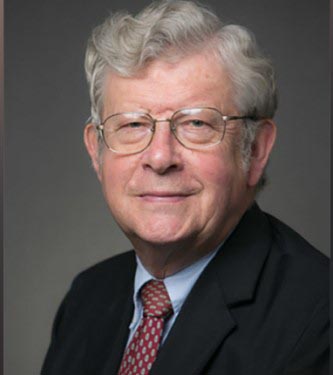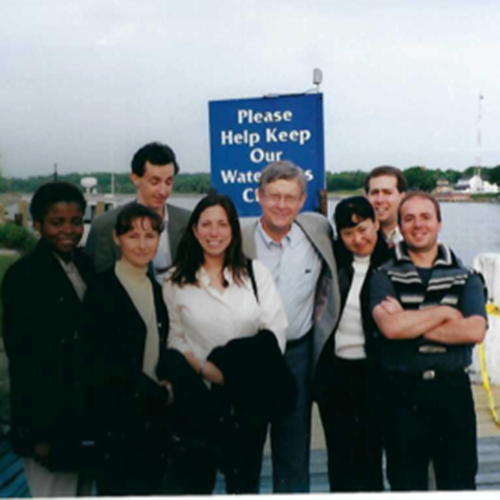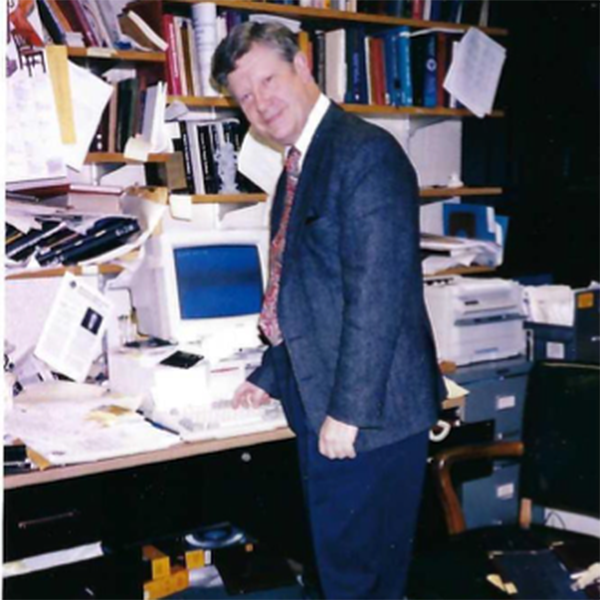September 4, 1937–June 27, 2023
Ned Heindel, Howard S. Bunn Emeritus Professor of Chemistry, marched up to the podium at the fall national meeting of the American Chemical Society. As the departing past president of the largest single science society in the world devoted to chemistry, he would deliver his final address.
The podium can be a bit of a snoozefest as officers often provide jargon-filled travelogues about what they accomplished that year.
Not Heindel. He seized the moment to outline where the society should go and nascent ideas that were sure to take off. He challenged the organization, of which he was a member for 56 years, to pursue those ideas and boldly step into the future.
While speaking, he slowly removed his sportcoat. He unknotted his skewed tie and slid it out from under his collar. He unbuttoned his Oxford.

If his speech wasn’t startling the crowd, his undressing surely was. Like Clark Kent, he soon revealed a hidden message to the world. His T-shirt, emblazoned with the Nike swoosh, proclaimed in bold letters: Just Do It.
The crowd took the moment to cheer.
In typical Heindel fashion, he wanted his peers to think big, work together, and tell compelling stories … many of the things that defined his career as a scholar, teacher, and member of the community — both at Lehigh and across the Lehigh Valley.
Undeterred by Setbacks
This mentality — in for a penny, in for a pound — started at a young age.
At 10 years old, he was at the workbench in his parents’ garage, fiddling around with a chemistry set he received on his birthday. The explosion is what his parents heard, stepping outside to see a hole in the concrete block garage wall. Unscathed he was. Undeterred he remained.
At 13, he and a friend got into his friend’s father’s gun cabinet. A shotgun went off, and a round of buckshot riddled Heindel’s shoulder and right arm. While it left him with lifelong issues in that appendage, he didn’t let such a setback slow him.
A bad auto accident prior to the start of chemistry graduate school injured his right hand. No matter. It only prompted him to learn to write with his left, so he could still take copious notes.
“A Distinct Possibility”
By that point in his life, he was married. He met Linda Heefner during his freshman year at Lebanon Valley College. A chapel session was required of all students. They sat in alphabetical order, and Heefner was a seat away from Heindel. He, of course, was studying chemistry while she, at that time, was studying biology.
His older female cousin, who also attended Lebanon, had taken him under her wing. It was she who encouraged Heefner to ask him to a Sadie Hawkins dance. As a shy young woman, Heefner worked up the courage to approach Heindel. When asked, he gave a curious answer: “That’s a distinct possibility.”
Not a clear yes or a clear no, which left Heefner standing there awkwardly for a moment, wordless. He did accompany her to that dance and was by her side from that day forward. They were married for 63 years.
“While I didn’t want to torture him in the early stages of our relationship by reminding him of his distinct answer, I did remind him later,” says Linda Heindel ’76G. “Anytime he was waffling on something, I’d say it sounded like a distinct possibility.”

Phenomenal Output and Impact
But he did not waffle often. Over the course of his career, “prolific” is the word that comes to mind for many of his peers.
Heindel published more than 300 journal articles on organic and medicinal chemistry, obtained 20 patents, and guided 40 doctoral students and 168 M.S. students through the programs at Lehigh.
“He had phenomenal output, and his impact on students was substantial,” says Jim Roberts, associate professor of chemistry and associate chair of the chemistry department. “He adopted an optimistic attitude with students that conveyed a clear belief: They could solve problems and prove what seemed impossible.”
The impact of that attitude was profound. Case in point is Bob Flowers ’91G '27P, dean of the College of Arts and Sciences.
Flowers was an undergraduate chemistry student at East Stroudsburg University when he heard Heindel give a lecture. They got talking afterward, and Heindel encouraged Flowers to consider doing summer research in the Lehigh chemistry department.
Flowers was a working-class student and planned to take a high-paying summer job at the Dixie Cup factory in Easton. Yet Heindel talked about why summer research would be good for him if he was considering graduate school. Flowers heard him and altered his plans, joining the department that summer.
“As a first-generation student in need of tuition assistance, following the sage advice from Ned altered the course of my life,” says Flowers. “I loved research, and my work that summer made me more competitive and prepared me as a graduate student applicant.”
By that point, any application seemed moot as Flowers joined Lehigh for his Ph.D., where Heindel remained a mentor and advocate despite Flowers’ work in a different research group.
“He was highly accomplished in all areas,” says Greg Ferguson '23P, professor of chemistry and chair of the chemistry department. “He was an awarded teacher and committed to service in our field.”
Heindel served on the boards of the American Chemical Society (ACS), Council for Chemical Research, International Union of Pure and Applied Chemistry-American Division, Chemical Heritage Foundation, Science History Institute, Chemical Sciences Roundtable of the National Academy of Sciences, Pennsylvania Drug Discovery Institute, and CentCom Advertising.

A Man Who Opened Doors for Others
Through this service, he had a legendary Rolodex.
“Any problem any person was facing, if Ned could not solve it himself, Ned knew someone who could help,” says Ferguson. “In fact, he’d drop everything to help a person.”
Sam Niedbala ’86G '12P knew that well. One day Heindel asked him if he had a sportcoat and tie. Niedbala did. Heindel told him to put them on and meet him at the faculty dining room. Niedbala didn’t know it was an alumni gathering. Heindel quietly introduced him to person after person.
“He opened the door to a whole group of successful people who worked in science,” says Niedbala. “He taught me how to network and made science feel social.”
Niedbala passed that same gift on, following suit with his students and young employees. “If they had a dream, I wanted to help them find others to make that dream a reality,” he says.
Heindel believed in Niedbala’s dream — his business, OraSure Technologies, started with experiments in Niedbala’s basement.
“Ned checked in with me, opened the doors at Lehigh for me to use equipment as a startup, and would always listen and give his perspective,” says Niedbala. “He was humble, relentless, caring, and endearing.”
Relentless is key.
“He’d find a thread and pull it,” says Natalie Foster '77G '82G, professor emeritus of chemistry. She herself was a thread.
As a woman with a chemistry degree in the early 1970s, Foster often hit walls, especially in hiring. As a result, she began teaching science at a private school. She then began a Master of Arts in teaching degree at Lehigh where she could take four courses in a primary area. She chose chemistry and signed up for an advanced undergraduate and graduate school course taught by Heindel.
One the first day, Heindel came into class with a cigar in his mouth and asked where the education major was. Foster stood up, and as one of the few women, made a pointed comment that put Heindel and her peers on their heels.

Following the first exam, Foster found a note written at the top of her paper: “See me.” When she approached Heindel, he asked what she was doing in education and then proceeded to shepherd her through a Master of Science, a Doctor of Arts, and a Doctor of Philosophy in chemistry at Lehigh.
Distance Learning Pioneer and History Buff
Foster was not alone in a Heindel-related degree track. He is considered by some on campus as the father of distance learning. In 1991, he helped create a distance education program at Lehigh, transmitting courses for a master’s in pharmaceutical chemistry by satellite. Students from 51 companies enrolled, allowing them to work while also advancing in the field. More than 120 students completed the program.
This relentlessness was applied to other areas.
“He was the quintessential researcher,” says Foster. “When he got into something, he dug in.”
That was the case with a book he wrote on a 19th century immigrant physician, James Munyon, who brought a flamboyant style and lucrative success to his sale of homeopathic cures — sugar pills that eventually led to the first indictment under the federal Pure Food and Drugs act. Munyon’s tie to Allentown caught Heindel’s interest … and he couldn’t let it go.
That happened time and time again. He published 16 articles and five books on topics of regional history. For more than 45 years, he and Linda were frequent contributors to articles for the Williams Township Historical Society.
His interest in history had him serve on the Northampton County Historical and Genealogical Society, the Science History Institute, the Williams Township Historical Society, and the Division of the History of Chemistry in the ACS.
In fact, he worked to create the Center for the History of Chemistry. Founded in 1982 by the University of Pennsylvania and the American Chemical Society, under Ned’s supervision, the center focused on studying the history of chemistry and related sciences and technologies; it later changed its name to the Chemical Heritage Foundation before becoming the Science History Institute.
“He was always excited to try new things,” says Linda Heindel. She remembers on one of their adventures abroad that he ate a local delicacy that had been buried underground for six months.
Legacy of Sharing
Together they set upon shaping a legacy that blended the personal and professional. They bought a house and barn in 1967 on Hexenkopf Ridge in Williams Township. Over the years, they acquired land around it.
At the center of the land is Hexenkopf Rock, a large outcropping of granite. Heindel wrote a book about the rock — legend has it that the sick, ill, and dying went to the rock where healers would transfer the afflictions into the stone, which resembles a witch’s head.
In 2020, the couple donated 76 acres including the rock to Northampton County, preserving the land and its stories for public use.
“It was a dream of his,” she says. “We wanted to share what we loved with others.”
That sharing continued when Linda created an endowment at Lehigh in her husband’s name “to help others shine.” The funds will support graduate students with needs beyond what’s paid for in their stipends, like conference fees and travel expenses.
“We wanted to help fill a gap,” she says.
Gaps are what Heindel seemed to specialize in — whether stories, knowledge, energy, or guidance.
A Storyteller With a Listening Ear
“He was always a great deal of fun to have around,” says Ferguson. “Ned could tell stories about any topic — names, buildings, facts, anecdotes, people, and places. He was a good storyteller and could just weave them into any conversation.”
“Every time I went to see him, Ned would put down what he was doing and ask how he could help,” says Roberts. “He always had time, advice, or a connection.”
“His office was filled with books, stacks of student essays and products, and file drawers blooming with paper,” says Niedbala. “Ned would sit in his big worn leather chairs or stand shoulder high among the stacks and know exactly where something was that you needed.”
“He walked fast and had an active mind, a vigor that we all admired,” says Foster.
“He was unassumingly successful,” says Niedbala. “People saw the smarts but didn’t also know all that he did and influenced.”
“He was an idea guy, creative, forward looking,” says Ferguson. “He had boundless energy.”
“He knew what he wanted to do and grabbed it by the horns,” says Linda. “He was good humored, even tempered, and never complained. Always a smile on his face.”
“When I was chair of the department, Ned would stop by late in the afternoon each Friday and ask how it was going,” says Ferguson. “He’d listen in a way that was valuable. It was a fabulous way to end the week.”


